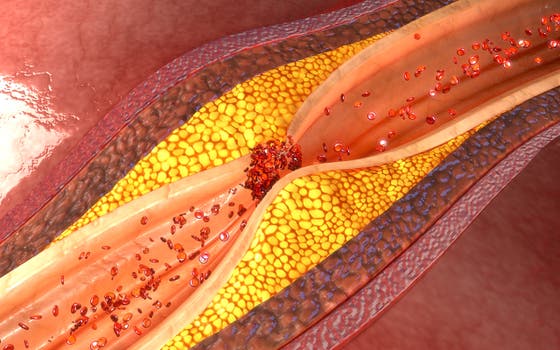Researchers discover different types of plaques in vessel walls for the first time

How a plaque is built up varies from patient to patient. Researchers from UMC Utrecht, Europe and the United States concluded that as many as five different types of plaques exist. These plaques, a local thickening of the vessel walls, differed in the presentation of symptoms and in the genetic risk for developing a heart or brain infarct in patients. The results of this study were published December 12, 2022, in the journal Nature Cardiovascular Research.
In arteriosclerosis, calcification causes the wall of the arteries to thicken. This thickening, a plaque, can lead to narrowing of the blood vessel and cause problems with blood flow to organs and tissues. Arteriosclerosis is a slowly progressive disease that can lead directly to a heart or brain attack. Prevention often focuses on treating the risk factors: diabetes, high blood pressure, cholesterol and lifestyle. Researchers long thought that arterial calcification in patients always develops the same way: that the plaque builds up in the vessel wall and becomes unstable in the same way. The latter triggers an acute blockage or narrowing of the blood vessel.
As many as five different types of plaque
Researchers found that plaque buildup shows great differences between patients and that there are as many as five different types of plaques. By studying the composition of genes, the researchers saw that there is no single disease pattern that develops the same in everyone. Patients in whom different types of plaques were found also showed differences in the presentation of symptoms and in the genetic risk for having a heart or brain attack. Gerard Pasterkamp, professor of Experimental Cardiology, explains, "The implications of these findings could be large, because we also have the impression that genes that respond to drug administration also show large differences between different types of plaques. For example, we see that genes that may respond to cholesterol drugs are found in one patient's plaque but not in another plaque."
The researchers made another finding. They found that plaques from mice (these are widely used in arterial calcification research) were very similar to plaques from only one group they found in patients. Most of the plaques from patients showed little resemblance to those found in the most commonly used animal models. The researchers believe this finding could go a long way toward understanding why some patients respond to treatment and others do not.
Biomarker in the blood
Gerard Pasterkamp: "Think about fever, for example. There are many diseases that can give rise to fever, but may require different treatment. If arteriosclerosis is a manifestation of something that involves different mechanisms, then you could look at the possible treatment with a different eye." In the future, the researchers will investigate whether the results can be translated into biomarkers. These are substances in the blood that tell whether you have arterial calcification and how severe it is. Taking a piece of vascular tissue from each patient is not possible, but if it is possible to measure a biomarker in the blood that is specifically associated with certain types of arteriosclerosis, then it is possible to map effects of treatment between patients.
About the study
In this study, researchers used the plaque tissue biobank Athero-Express. Researchers at UMC Utrecht have collected more than 2,500 plaques over the past 20 years from patients who had a narrowing in the carotid artery that was surgically removed. Over this period, they have built the largest plaque tissue biobank in the world that is widely used in arterial calcification research.
Read the results of this study in the journal Nature Cardiovascular Research.
